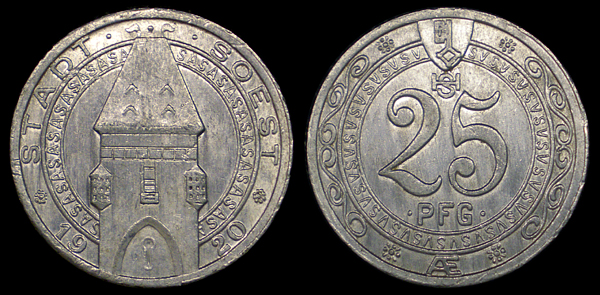
STADT SOEST (GERMAN) 25 PFENNIG 1920
L- 489.6 City of Soest (Westfalen) Aluminum 25 Pfennig Coin.
This coin was issued in 1920 by the German city of Soest. On the obverse is a depiction of the Osthofentor with the date and city name. On the reverse is the denomination and a depiction of a key which is the city coat of arms.
Soest is a German city of almost 50,000 people in North Rhine-Westphalia, Located near the Ruhr river along the old Hellweg trade route. Formerly the capital of Westfalen, today it is the capital of the Soest District.
Although the city is first mentioned in historical writings around 836 AD, archeological evidence suggests that the fertile loess soil of the area has supported human settlements for more than 4000 years. By the middle ages Soest had grown to be a city of almost 10,000 residents and was an important member of the trading alliance known as the Hanseatic League.
After declaring itself independant from the Bishop of Cologne and Westfalen in the mid 15th century, the city's fortunes waned. Soest aligned itself with the Duke of Cleves until the last of that line died and the city was passed to Brandenburg. Once the largest city in Westfalen, Soest suffered greatly during the Thirty Years War losing a large percentage of the population to war and disease.Soest regained a measure of importance when, In 1816, Prussia created the Soest district with the city of Soest as its capital (seat).
Eventually industrialization crept through the Ruhr area but largely passed Soest by. This may be the reason why the city emerged from two world wars relatively unscathed compared to other cities in the region. After World War II Soest became a garrison for Canadian, British and Belgian soldiers.
Soest, like most other German cities, issued notgeld during and after World War I. The city issued several series of coinage in zinc (1917) and aluminum (1920). The early issues in zinc were of a more simple design, all denominations depicting the city coat of arms. The later issues in aluminum depicted several different city historical land marks like the the Osthofentor (above) or the Saint Patroclus's Cathedral.
On the obverse of this coin is the Osthofentor. It is one of the only remaining parts of the town’s original walled fortifications. It is a former city gate (one of ten), built with local greenish sandstone in the period of 1523 to 1526. Today the gateway houses an historical museum which hosts old weapons including a collection of 25,000 medieval crossbow bolts.
